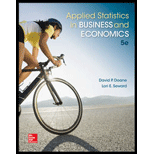
Concept explainers
What are
a.
Define descriptive statistics
Explanation of Solution
Descriptive statistics:
If a sample is taken and some statistics or sample characteristics are obtained from the sample but no inference is made about the entire population by using this information which is available from the sample, then it is termed as descriptive statistics.
The descriptive measures have three key characteristics:
- Center
- Variability
- Shape
Measures of Center:
An individual value that attempts to describe an observation by identifying the central position of the sample data is known as measures of central tendency.
Characteristics of center:
- Mean
- Median
- Mode
- Midrange
- Geometric mean
- Trimmed mean
Variability:
The measures of variability calculate the amount of spread or deviation in the observations. If the values corresponding to the variability are high, it means that the values in the data set are spread out wide.
Characteristics of the variability:
- Range
- Sample variance
- Sample standard deviation
- Coefficient of variation
- Mean absolute deviation
Measures of shape:
The shape of the data can be predicted by having the view on the shape of the graphs like histogram or boxplots or by comparing the value of the mean and median.
b.
Explain how the descriptive measures differ from the visual displays of data.
Explanation of Solution
The statistical method helps to organize, explore and summarize the raw data in to useful information. The methods of statistics may be in visual form (Charts or graphs) or numerical form (Statistics or tables). In statistics, data visualization deals with the charts and graphs. A surveyor uses the visual form of data for clear explanation. In common, it is a practice to continue an analysis by examining graphical displays of the data set. The method of visual representation makes the people to understand the data easily.
However, the visualization has the clear logical ideas but it also needs some descriptive reports about the data. It is hard to visualize the raw data into graphical form without any descriptive measures. In order to analyze the data set, descriptive measure will give clear explanation along with graphical representation.
Want to see more full solutions like this?
Chapter 4 Solutions
Applied Statistics in Business and Economics
Additional Math Textbook Solutions
Graphical Approach To College Algebra
Finite Mathematics for Business, Economics, Life Sciences and Social Sciences
Elementary Statistics: Picturing the World (7th Edition)
Introductory Statistics
Elementary & Intermediate Algebra
- A company found that the daily sales revenue of its flagship product follows a normal distribution with a mean of $4500 and a standard deviation of $450. The company defines a "high-sales day" that is, any day with sales exceeding $4800. please provide a step by step on how to get the answers in excel Q: What percentage of days can the company expect to have "high-sales days" or sales greater than $4800? Q: What is the sales revenue threshold for the bottom 10% of days? (please note that 10% refers to the probability/area under bell curve towards the lower tail of bell curve) Provide answers in the yellow cellsarrow_forwardFind the critical value for a left-tailed test using the F distribution with a 0.025, degrees of freedom in the numerator=12, and degrees of freedom in the denominator = 50. A portion of the table of critical values of the F-distribution is provided. Click the icon to view the partial table of critical values of the F-distribution. What is the critical value? (Round to two decimal places as needed.)arrow_forwardA retail store manager claims that the average daily sales of the store are $1,500. You aim to test whether the actual average daily sales differ significantly from this claimed value. You can provide your answer by inserting a text box and the answer must include: Null hypothesis, Alternative hypothesis, Show answer (output table/summary table), and Conclusion based on the P value. Showing the calculation is a must. If calculation is missing,so please provide a step by step on the answers Numerical answers in the yellow cellsarrow_forward
 Holt Mcdougal Larson Pre-algebra: Student Edition...AlgebraISBN:9780547587776Author:HOLT MCDOUGALPublisher:HOLT MCDOUGAL
Holt Mcdougal Larson Pre-algebra: Student Edition...AlgebraISBN:9780547587776Author:HOLT MCDOUGALPublisher:HOLT MCDOUGAL Glencoe Algebra 1, Student Edition, 9780079039897...AlgebraISBN:9780079039897Author:CarterPublisher:McGraw Hill
Glencoe Algebra 1, Student Edition, 9780079039897...AlgebraISBN:9780079039897Author:CarterPublisher:McGraw Hill Big Ideas Math A Bridge To Success Algebra 1: Stu...AlgebraISBN:9781680331141Author:HOUGHTON MIFFLIN HARCOURTPublisher:Houghton Mifflin Harcourt
Big Ideas Math A Bridge To Success Algebra 1: Stu...AlgebraISBN:9781680331141Author:HOUGHTON MIFFLIN HARCOURTPublisher:Houghton Mifflin Harcourt


